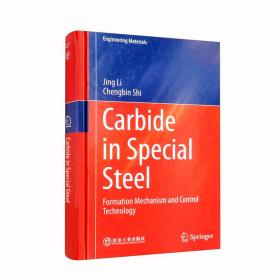
新华正版 Carbide in Special Steel - Formation Mechanism and Control Technology 李晶//史成斌 9787502487737 冶金工业出版社
新华书店直发 全新正版 急速发货 开票联系客服
¥ 132.95 4.4折 ¥ 299 全新
库存40件
作者李晶//史成斌
出版社冶金工业出版社
ISBN9787502487737
出版时间2019-12
装帧精装
开本16开
定价299元
货号11510108
上书时间2024-08-20
- 在售商品 暂无
- 平均发货时间 17小时
- 好评率 暂无
- 最新上架
商品详情
- 品相描述:全新
- 商品描述
-
目录
1 Carbides in Special Steel
1.1 Carbide and Its Characterization Method
1.1.1 Definition of Carbide
1.1.2 Types of Carbide
1.1.3 Analysis Method of Carbide
1.2 Thermodynamic Analysis of Carbide Formation in Special Steel
1.2.1 Thermodynamic Analysis of Carbide Formation in Austenitic Hot Work Die Steel
1.2.2 Thermodynamic Analysis of Carbide Formationin 8Cr13MoV Steel
1.2.3 Thermodynamic Analysis of Carbide Formation in High Speed Steel
1.2.4 Thermodynamic Analysis of Carbide Formationin H13 Hot Working Die Steel
1.2.5 Thermodynamic Analysis of Carbide Formationin Cr5 Rolling Steel
1.2.6 Thermodynamic Analysis of Carbide Formation in GCr15 Bearing Steel
1.3 Growth Characteristics and Morphology Analysis of Carbide
1.3.1 Morphology Analysis of Carbide
1.3.2 Formation Characteristics of Primary Carbide
1.3.3 Precipitation and Growth Behavior of Secondary Carbides
1.4 Influence of Carbide on Properties of Steel and Its Control Method
1.4.1 Effect of Electroslag Remelting on Primary Carbide in Steel
1.4.2 Effect of Carbides on the Properties of Steel
1.4.3 Controlling Method of Carbide
References
2 Carbides Control in Electroslag Remelting Process
2.1 Effects of Parameter of ESR on the Primary Carbides
2.1.1 Effect of Melting Rate of ESR on Primary Carbidesin Steel
2.1.2 Effect of Fill Ratio in ESR Process on Primary Carbides in 8Cr13MoV Steel
2.1.3 Effect of Cooling Intensity of ESR on the Primary Carbides
2.2 Effect of Continunous Directional Solidification of Electroslag Remelting on the Carbide Segregation
2.2.1 Effect of Directional Solidification of Electroslag Remelting on the Dendrite Arm Spacing
2.2.2 Morphology of Dendrite Growth in ESR Ingots
2.2.3 Effect of Directional Solidification of Electroslag Remelting on the Carbon Segregation
2.3 Carbide Control in Steel Based on Continuous Directional Solidification Electroslag Remelting
2.3.1 Effect of Continuous Directional Solidification Electroslag Remelting on the Size and Amount of Carbide
2.3.2 Effect of Continuous Directional SolidificationElectroslag Remelting on the Three-Dimensional Structure of Carbides
2.3.3 Performance Analysis of Directional Solidified ESR Ingots
References
3 Carbide Control in Rolling Process
3.1 Effect of Cogging Down and High Temperature Diffusion Annealing Process on the Carbide
3.1.1 Effect of Cogging Down on the Carbide
3.1.2 Effect of Diffusion Annealing of ESR Ingoton Primary Carbide
3.1.3 Effect of Diffusion Annealing of Hot Rolling Slab on Primary Carbide
3.1.4 Effect of High Temperature Diffusion Annealing on Network Carbides in High Carbon Steel
3.2 Effect of Hot Rolling Process on Carbide
3.2.1 Effect of the Deformation in Hot Rolling on Carbide
3.2.2 Effect of Hot Rolling Temperature on Carbide
3.2.3 Effect of Rolling Temperature on Reticulated Carbides in GCr15 Bearing Steel
3.3 Effect of Hot Rolling Process on Carbide
3.3.1 Carbide and Microstructure Analysis of Cold Rolling Slab
3.3.2 Effect of Carbon Content on Carbides in Cold Rolling Slab
3.3.3 Effect of Thickness of Cold Rolling Slab on Carbide
3.3.4 Effect of Cold Rolling Slab Thickness on the Mechanical Properties of Steel
References
4 Effect of Heat Treatment on the Carbide in Steel
4.1 Effect of Spheroidizing Annealing Process on Carbide
4.1.1 Evolution of Carbides During Spheroidizing Annealing
4.1.2 Effect of Austenitizing Time on the Carbides and Mechanical Property of Annealed Steel
4.1.3 Effect of Spheroidizing Time on the Carbides and Mechanical Property of Annealed Steel
4.1.1 Effect of Cooling Rate on the Carbides and Mechanical Property of Annealed Steel
4.2 Quenching Process on the Carbides in Steel
4.2.1 Phase Transformation Temperatures of 8Cr13MoV Steel
4.2.2 Effect of Quenching Process on the Carbides of Steel
4.2.3 Evolution of Microstructure During Quenching Process
4.2.4 Effect of Quenching Process on the Mechanical Property of Steel
4.3 Effect of Tempering on the Carbides of Steel
4.3.1 Effect of Tempering Temperature on Carbides and Microstructure
4.3.2 Effect of Tempering Temperature on Mechanical Properties
4.3.3 Effect of Tempering Temperature on Corrosion Performance
4.4 Effect of Roll Forging Heat Treatment on Carbide
4.4.1 Effect of Roll Forging Heat Treatment Process on Grain Size
4.4.2 Effect of Roll Forging Heat Treatment on Carbide
4.4.3 Effect of RF Process on the Sharpness of Steel
5 Effect of Magnesium on the Carbide in H13 Steel
5.1 Formation and Removal of Mg Bearing Inclusions in H13 Steel
5.1.1 Physical Properties of Mg Bearing Inclusions
5.1.2 Collision and Agglomeration of Al2O3 and MgO-Al2O3 Particles
5.1.3 Factors Affecting the Magnitude and Action Radius of Long-Range Attractive Force
5.1.4 Effect of Magnesium on Inclusions in H13 Steel During ESR
5.2 Analysis on the Effect of Mg-Containing Inclusionon the Carbide
5.2.1 Effect of Mg Addition on Carbides in H13 Steel
5.2.2 Effect of Mg Content on Segregation of Alloy Elements
5.2.3 Mechanism of Refining and Spheroidizing Carbidesby Mg
5.3 Effect of Heat Treatment Process on Carbides Type and Distribution of Mg Contained H13 Steel
5.3.1 Evolution of Carbides in H13 Steel in Heat TreatmentProcess
5.3.2 Effects of Mg on Carbide Type and Distributionin H13 Die Steel After Annealing
5.3.3 Effect of Mg on Carbides Type and Distributionin H13 Die Steel After Quenching and Tempering
5.4 Effect of Magnesium on Mechanical Properties of H13 Die Steel
5.4.1 Effect of Magnesium on Phase Transformation of H13Die Steel
5.4.2 Effect of Magnesium on Thermal Stability of H13 Die Steel
5.4.3 Effect of Magnesium on Mechanical Propertiesof H13 Die Steel After Annealing
5.4.4 Effect of Magnesium on Properties of H13 Die Steel After Quenching and Tempering
5.4.4 Effects of Magnesium on Wear Resistance of H13 Die Steel
References
6 Effect of Rare Earth on the Carbide in Steel
6.1 Effect of Rare Earth on Inclusion Behavior in Steel Before and After ESR
6.1.1 Effect of Rare Earth on the Quantity and Morphology of Inclusions
6.1.2 Effect of Rare Earth on the Morphologyand Composition of Inclusions
6.1.3 Effect of Rare Earth on the Microstructure
6.2 Effect of Rare Earth Inclusion on the Carbide
6.2.1 Effect on Rare Earth Inclusion on the Carbide of Austenitic Hot-Work Die Steel
6.2.2 Effect of Rare Earth Inclusion on the Carbide
6.3 Effect of Heat Treatment on Carbides in Rare Earth Austenitic Hot-Work Die Steel
6.3.1 Microstructure of Rare Earth Microalloyed Austenitic Hot-Work Die Steel
6.3.2 Effect of Rare Earth on Grain Boundary in Austenitic Hot-Work Die Steel
6.4 Effect of Rare Earth on Mechanical Properties of Austenitic Hot-Work Die Steel
References
7 Effect of Nitrogen on the Carbide in Steel
7.1 Thermodynamic Analysis of the Effect of Nitrogen on the Precipitation Phase of Austenite Hot Work Die Steel
7.1.1 Effect of Nitrogen on Precipitation Temperature of Precipitation Phase
7.1.2 Effect of Nitrogen on the Composition of PrecipitationPhase of Austenite Hot Work Die Steel
7.2 Effect of Nitrogen on the Microstructure and Precipitation Phase of Annealed ESR Ingot
7.2.1 Effect of Nitrogen on the Dendrites of Annealed ESR Ingot
7.2.2 Effect of Nitrogen on Precipitation Phase of ESR Ingots
7.3 Effect of Heat Treatment Process on the Structure and Precipitates in Nitrogen-Containing Austenitic Die Steel
7.3.1 Effect of Solution Heat Treatment on Carbides in Steel
7.3.2 Effect of Aging Heat Treatment on Carbides in Steel
7.3.3 Effect of Heat Treatment on the Mechanical Properties of Carbides of N-Containing Austenitic Die Steel
References
8 Feasibility Analysis of Titanium on Carbide Control in HighCarbon High Alloy Steel
8.1 Effect of Titanium on the Carbides in Ingot
8.1.1 Effect of Titanium on the Type of Carbides
8.1.2 Effect of Titanium on the Composition of Carbides
8.1.3 Effect of Titanium on the Morphology of Carbides
8.2 Effect of Titanium on Forged Microstructure and Annealed Organization
8.2.1 Influence of Titanium on Forged Microstructure
8.2.2 Influence of Titanium on Spheroidizing Annealed Microstructure
8.3 Feasibility Analysis of Ti Treatment on High Carbon Alloy Steel
8.3.1 Effect Mechanism of Ti on Carbides in High Carbon Alloy Steel
8.3.2 Feasibility of Ti Treatment on Carbide Control in High Carbon Alloy Steel
References
内容摘要
《特殊钢中碳化物控制:英文》由李晶,史成斌著
精彩内容
本书系统阐述了特殊钢生产中在电渣重熔、轧制和热处理过程中碳化物的演变与控制,以及稀土、镁、氮、钛等合金元素作为异质形核剂进行合金化处理对特殊钢中碳化物的影响。
本书可供冶金、材料等领域的科研、生产、教学、管理人员阅读参考。
相关推荐
-

Carbide in Special Steel - Formation Mechanism and Control Technology
全新北京
¥ 140.23
-

Carbide in Special Steel - Formation Mechanism and Control Technology
全新广州
¥ 140.77
-

Carbide in Special Steel - Formation Mechanism and Control Technology
全新北京
¥ 138.50
-

Carbide in Special Steel - Formation Mechanism and Control Technology9787502487737
全新广州
¥ 147.35
-

【假一罚四】Carbide in Special Steel - Formation Mechanism and Control Technology李晶//史成斌
全新嘉兴
¥ 161.70
-

Carbide in Special Steel - Formation Mechanism and Control Technology 李晶//史成斌 冶金工业出版社
全新泰安
¥ 144.72
-

Carbide in Special Steel - Formation Mechanism and Control Technology 9787502487737 李晶//史成斌 冶金工业出版社
全新北京
¥ 161.50
-

in投行 财政金融 投行小兵 新华正版
全新无锡
¥ 50.70
-

lotus flowercultivars in china 种植业 王其超 新华正版
全新无锡
¥ 187.00
-

lotus flowercultivars in china 种植业 王其超 新华正版
全新保定
¥ 187.50
— 没有更多了 —












以下为对购买帮助不大的评价